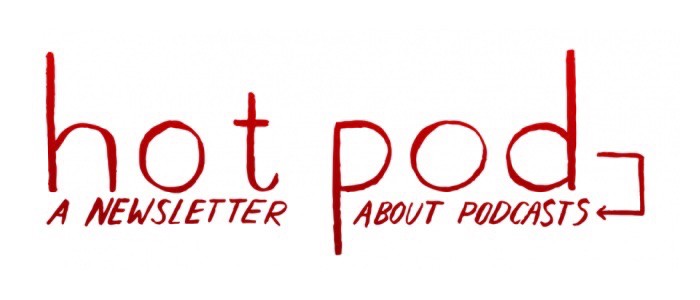
Welcome to Hot Pod, a newsletter about podcasts. This is Issue Sixty-Four, published March 15, 2016.
Happy post-Pi day! Let’s celebrate with waffles.
Infinite Dial. The numbers are in, and…well, they’re looking quite good. Last Thursday, Edison Research dropped the latest edition of their annual “Infinite Dial” report, a survey study that looks at consumer adoption of digital media. The report, which is conducted in partnership with Triton Digital, has a particular emphasis on audio, though it also contains pretty fascinating excursions into social media and whatever’s going on in the streaming space more broadly. And, unless I’m committing a massive piece of oversight here, it’s also the biggest reputable independent study that has observed the podcast format almost since the medium’s inception, with survey data going back to 2006. (That’s a long time, guys! A long time!)
Do check out the whole report on Edison Research’s website, but here are the three big things that are stuck in my head:
1. Mainstream. According to the study, an estimated 98 million Americans have listened to a podcast at least once in their lives. Put another way, that’s more than 1 in 3 Americans surveyed by this study. I mean, that measure is pretty dramatic, and it also sounds pretty loose — just because you tried something doesn’t mean that something is meaningful. But then again, it does show that you at least know about the thing enough to actually try it out. But if you contextualize that these two other data points:
…you get a picture of a medium trending towards a fairly hopeful future. The study also pretty strongly declared: “Nearly 100 million Americans have ever listened to a podcast — it has made the jump to mainstream.”
2. Gender. According to the study, the number of women consuming podcasts has effectively doubled since 2013. Specifically, 18 percent of women surveyed report having listened to a podcast within the past month, up from 9 percent in 2013. Data still confirms that podcasting is a predominantly white male thing, but I’m fairly confident that this trend of gender diversification will continue, if only for the reason that enough people making stuff for the market are going to figure out that gender and race-inclusive programming is a positive value differentiator.
3. The continuing shift toward mobile. 64 percent of respondents who consume podcasts report doing so primarily on their mobile devices, up from 55 percent in 2015. Though some may well find it strange that a significant chunk of people consume podcasts on desktop in the first place, it’s actually a fairly established consumption behavior, especially when you think back to how difficult it was to catch a podcast on your phone before the great gods of Apple decided to bundle the native Podcasts app, which is widely understood to drive roughly 70 percent of podcast consumption, into iOS by default. (FWIW, a ton of my listening happens on desktop, both on headphones and through my Bluetooth speaker, which I also happen to take into the shower with me. Probably too much information, but I’m just sketching out, you know, multiple use cases and such.)
Related to this desktop situation is whether significant podcast consumption happens on YouTube, which is a fair inquiry because, according to the Infinite Dial study, a sizable portion of music consumption takes place there (14 percent of respondents report using YouTube most often to keep up-to-date with music, to be exact), and we can presumably suggest that the behavior might map onto podcasts. I personally haven’t found any reliable sources concretely proving this behavior on a wide scale, though I have seen some successful case studies of YouTube-as-podcast-consumption-source. Most notably, Welcome to Night Vale and some shows under the Loud Speakers Network tend to drive tens of thousands of listens through their YouTube channels, and podcasts with strong video components — like KindaFunny and some of the old Grantland shows — also tend to post strong numbers on the platform.

So that’s the big stuff from the study that I wanted to talk about. But there is one more thing that I want to riff on, if you’d be so kind to indulge me:
What’s in a word? Right now, the Infinite Dial report’s definition of a podcast is pegged to a classic description: the consumption of non-music audio content through an on-demand delivery channel, typically in the shape of the Apple podcasting app and its myriad of smaller, direct competitors (Overcast, Stitcher, and so on). But as we move deeper into the year, we’re going to see several developments that will significantly challenge the clarity of that definition. Namely:
For what it’s worth, I’m fairly certain that, with its liberation from an infra-structurally imposed definition, the word “podcast” will lose all of its original meaning by the end of the calendar year. My sense is that it will likely become an identifier for a certain corner of a reconstituted landscape of all non-music audio content that’s created and distributed digitally. It’s a scope that will not only include the new podcasting companies of the last year or so, public radio, and digital media companies developing new audience development channels in the audio space (which have been my topical biases, in case you haven’t already noticed), but also commercial radio powers, streaming and Internet radio companies like iHeartMedia and SiriusXM, and community radio infrastructures.
It’s a kind of convergence; or, if you’d allow me some drama, a kind of collision.
As you can imagine, this poses an editorial challenge for me. I’ve never pretended to be comprehensive in scope with Hot Pod, but I’ve always been focused on a certain narrative of change — and power — when I sit down and choose stories to pursue every week. So, with this expected shift, I’m still not quite sure how I’ll adapt my terms and coverage, but I should figure it out and whip out, like, a mission statement pretty soon, I imagine.
The value-add of a podcast network. Slate president Keith Hernandez was on the Digiday podcast last week, and in addition to talking about the larger developments on the business and advertising fronts of the 20-year-old publication, he also got the chance to talk a bit about the company’s sister podcasting business, Panoply — which I used to work for, by the way, in case you’re new to this column. I never got to work directly with Hernandez back when I was bumming around the Slate offices, so it’s interesting to me to hear how he articulates the company’s value proposition.
Anyway, there’s a bit in the conversation that stood out to me where Digiday’s Brian Morrissey astutely points out the fundamental challenge of podcast networks, or any network in general for that matter:
Morrissey: Is it one of those things when someone becomes…It’s like ad networks always have this problem, their clients always wanted to fire them because they wanted to become self-sufficient so they wouldn’t have to share [revenue]. Is that a thing where people get to a certain size, they sort of leave behind the network?
Hernandez: I don’t think anybody wants to be a logo on a slide, you know? What we care about on that end, when working with big partners and big publishers, is how can we be more than just a network, that logo on a slide? How can we provide help on the production end, how can we provide insights, the right music supervisor and producers for their shows? It’s more a partnership on the creation side than it is a partnership on the monetization side.
You can check out the whole conversation on Digiday. The section on Panoply begins at the 17:00 mark.
In tangentially related news, two partner shows on the Panoply network have lost significant talent over the past two weeks.
This brings to light a tension, one that’s logistical but also creative, that lies at the heart of podcasts created by publications: what are listeners responding to — the publication’s brand, or the personality on the show?
On the flip side, Slate launched a pop-up podcast yesterday called Trumpcast, which features short (~15 minute) near daily audio reporting by (the very boss) Jacob Weisberg, Slate Group’s editor-in-chief and chairman, on all things Trump. This thing is great, guys; it’s such a smart, swift way to leverage newsroom resources to create something that speaks directly to the present moment. Gah, it makes me so angry how good and specific and focused it is.

Given its ambiguous capacity to adequately convey value, I was curious about the extent to which the charts reflect value outwards. Specifically, I wanted to know how it influences the thinking of advertisers, and whether it creates informational inefficiencies that makes it difficult for advertisers to find decent campaign opportunities, for ad buyers to buy ads, and for creators to create sustainable revenue streams. I asked around, and found that podcast advertisers and media buyers do, indeed, rely on the charts for information, but only to a point. (Thankfully.)
“Advertisers mostly care about whether a show drives results for them,” said Lex Friedman, Midroll Media’s EVP of sales and development. “But certainly, there’s a core group of advertisers I hear from anytime they notice a new show catapult into the Top 10. They don’t mind if a show that’s already working doesn’t rank there; they know the numbers and are happy regardless. But when a new show jumps into the iTunes charts, advertisers are definitely curious about whether we represent it, or know who does, and can help them get on it.”
Karo Chakhlasyan, a media buyer with Los Angeles-based ad agency Oxford Road, agrees with this perspective. “As a buyer, it doesn’t really matter to me where a podcast is on the charts,” he told me over the phone last week. “But it does play a role in outreach. Every Tuesday, I get together with one of our media coordinators and go through the list to see if a podcast broke into the Top 200 or got featured. And then we get the podcast on the phone and try to get a general idea of whether we’re able to buy.”
But the charts’ particularities often generate poor leads for advertisers. Chakhlasyan describes often finding himself on calls with small podcasts that have short shelf-lives. “Usually, those calls don’t pan out too well because it usually turns out that they’re not really serious about the show. Maybe they’re on the charts by luck, or some lucky marketing push that gets them featured,” he explained.
At the same time, however, the charts have been helpful for advertisers to check against…let’s call it improprieties. “Advertisers have also used the iTunes charts (in part) to get wise when a show touts numbers that don’t add up,” said Friedman. “For example, if you hear a show is doing 1.5 million downloads per episode, and it doesn’t rank anywhere in the iTunes Top 200, you know that what you’re hearing is hooey.”
Next week, I close out this mini-series on iTunes with some notes on what the future might look like with respect to podcast charts. Cool? Cool.
Relevant bits:
Is this your first time reading Hot Pod? You can subscribe to the newsletter here. It’s got more stuff, and then a couple more things, but really I’m just happy you’re here with me.
Hot Pod is Nicholas Quah’s weekly newsletter on the state of the podcast world; it appears on Nieman Lab on Tuesdays.